How to Distinguish Paint Quality with Paint Thickness Gauge?
Paint is a colored pigment with a sticky appearance. It can adhere firmly to objects and is generally flammable without drying. Paint is rich in chemical properties. It will not dissolve in water, but it can dissolve in alcohol, aldehyde, ether, benzene, alkane, gasoline, kerosene, diesel, etc. It can be said that the composition of paint is quite complicated, so the testing standards for paint are also diverse. If you want to get accurate data, you can consider to use a paint thickness gauge. This method is feasible and still very practical.
Paint contains a lot of organic macromolecules, such as paints, natural resins, synthetic resins, etc. These chemicals have a certain adhesion, which can allow paint to form a film on the object surface. This layer of film is not only colorful, it can decorate and beautify the items, but also protect the internal materials and prevent corrosion by external environmental damage over time.
The chemical substances that assist paint formation are also called adjuvants, auxiliaries and solvents. These substances are largely affected by concentration, proportion, content and volatile properties. Therefore, the properties of various paints are different and the corrosion resistance requirements of products are also different. Paints often have differences in thickness. For ordinary people who buy paint to spray by themselves, the general paint instructions have a recommended spray thickness, the primer is generally 20 ~ 50μm and the topcoat is almost 40 ~ 80μm.
Second, use the paint thickness gauge to detect the film thickness
But do you really distinguish between really good paints? Do you really know the true spray thickness of the paint? These are without exception, all need to use a professional and precise paint thickness gauge to determine the paint film thickness.
According to national standards, paint thickness standards: thickness should be not less than 75 μm, middle paint film thickness should be not less than 100 μm, top paint thickness should be not less than 50 μm. After the completion of paint, the total dry paint thickness is not less than 225 μm. The shelf life of exterior paints is 5 years and paints must not produce bubbles, corrosion, discoloration or peeling within 5 years.
When the thickness measurement of paint is really used in life, it is necessary to pay attention to the more important work in mechanical refurbishment of paint and coating products. They are collision and anti-collision, that is, high mechanical strength. In order to reach the expected strength, we must consider the thicker the film, the higher the hardness of the paint film and the better the adhesion. Take the use of epoxy zinc-rich primer to match the polyurethane paint coating as an example. The zinc-rich primer thickness is generally not less than 70 μm and the polyurethane paint spray thickness is about 30-35 μm / in ordinary anticorrosive and decorative coatings. For example, it can be painted with 40μm epoxy primer, 50-60μm epoxy mica intermediate paint and 30-40μm polyurethane topcoat. With the help of the Linshang LS220H paint thickness gauge, the measuring range is 0.0-2000μm. Its measurement accuracy is also ≤ ± (3% of reading + 2 μm).
Depending on the nature of the paint, sometimes higher temperatures are required in order to dry the paint more quickly. In view of this situation, a paint thickness gauge with a temperature compensation function is necessary. This paint thickness gauge can effectively adapt to a variety of high and low temperature environment. The instrument can ensure the stability and accuracy of test data.
- High precision coating thickness gauge for used car
- Automotive paint protection films coating thickness gauge
- Plating Thickness Measuring Instrument for Detecting Anti-corrosion Coating
- Linshang LS220, LS191, LS160A– Necessary for Car Cover Inspection
- Coating Thickness Gauge for Second Hand Vehicle
- Zero Adjustment Step of Coating Thickness Gauge
